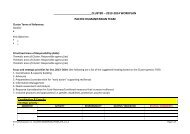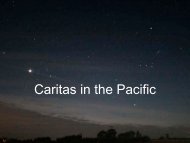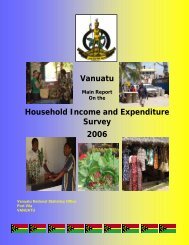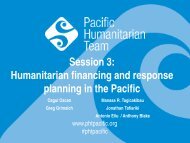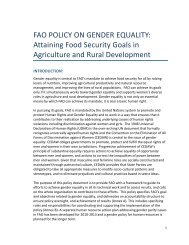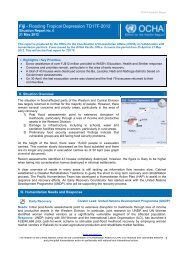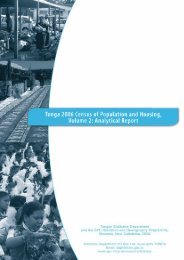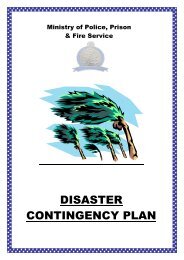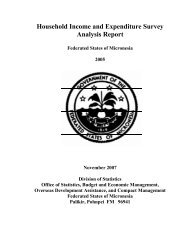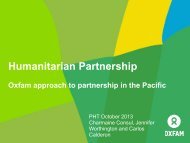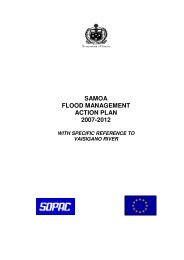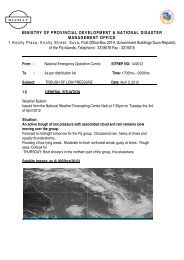<strong>Solomon</strong> <strong>Islands</strong>: Analysis of Poverty from 2005/2006 HIES6. This analysis of poverty and hardship in <strong>Solomon</strong> <strong>Islands</strong> is one of a series of national poverty reports beingcompiled cooperatively by national statistics offices, SPC, ADB and UNDP <strong>Pacific</strong> Centre based on <strong>the</strong> recentround of household surveys. These national reports benefit from a standard methodology as agreed at <strong>the</strong> SPCcoordinated Regional Heads of Planning and Heads of Statistics Meeting held in Noumea in September 2007 anda subsequent technical workshop held in November.2. Introduction2.1 Defining Hardship and Poverty in <strong>the</strong> <strong>Solomon</strong> Island Context7. Traditional <strong>Solomon</strong> Island society, as well as <strong>Pacific</strong> societies generally, embraces caring for and sharing withfamily and clan. As a result, <strong>the</strong>re is a continuing belief that poverty cannot and should not be a part of normallife in <strong>the</strong> <strong>Pacific</strong> region. The suggestion that <strong>the</strong>re might be poverty in some form is not, <strong>the</strong>refore, somethingthat many people have been prepared to readily accept. Indeed, <strong>the</strong> usual images of poverty (starving children,landless peasants, and men and women toiling with ox ploughs) do not immediately spring to mind in relation to<strong>the</strong> <strong>Pacific</strong> or <strong>Solomon</strong> <strong>Islands</strong>.8. While <strong>Solomon</strong> Islanders might not be well off in financial or material terms, <strong>the</strong>ir strong family and community tieshave traditionally provided social safety nets for <strong>the</strong> most disadvantaged and vulnerable. However, <strong>the</strong> increasingmonetisation of <strong>Pacific</strong> economies, <strong>the</strong> impact of television and internet, and increasing rural/urban migrationleading to greater urbanisation, have begun to undermine <strong>the</strong>se traditional structures.9. As a consequence poverty and hardship, as now defined and understood in <strong>the</strong> <strong>Pacific</strong>, (see Section 2.2), arebeing increasingly accepted as concerns which need greater attention from <strong>the</strong> development community. Somecountries in <strong>the</strong> <strong>Pacific</strong> region, including Fiji <strong>Islands</strong>, Papua New Guinea (PNG), and Timor-Leste, have fully embraced<strong>the</strong> need to deal with increasing levels of hardship and poverty and <strong>the</strong>ir societal implications. O<strong>the</strong>r countries,though perhaps not yet acknowledging hardship and poverty as serious issues, are never<strong>the</strong>less accepting that<strong>the</strong>re are growing numbers of disadvantaged people who are being left behind as economic and social structureschange in response to both external and internal developments. However, poverty and hardship must be seen asissues that are best dealt with before <strong>the</strong>y become serious.10. What does poverty mean <strong>the</strong>n in <strong>the</strong> <strong>Solomon</strong> Island context? In so far as an internationally recognised “official”definition exists it is widely accepted as <strong>the</strong> US$1 per capita per day of Millennium Development Goal 1. But, asyet, this figure is not available for <strong>Solomon</strong> <strong>Islands</strong> (or <strong>Pacific</strong> countries generally) because <strong>the</strong> “purchasing powerparity” indices on which this definition is based are still being developed for <strong>the</strong> <strong>Pacific</strong> situation. Instead, for anincome or expenditure based poverty indicator, we need to look at national basic-needs poverty lines.11. National basic needs poverty lines are estimated from <strong>the</strong> cost of a minimally-nutritious, low-cost diet whichdelivers a minimum of 2100 calories (Kcal) per day plus adequate additional nutrition to provide a sound andbalanced, but basic, diet. To this is added an amount for essential non-food expenditure (e.g. housing, transport,education, clothing, utilities) which is required to provide an overall basic needs standard of living. Householdswhich have per capita incomes or expenditure below <strong>the</strong> basic needs poverty line are <strong>the</strong>n deemed to be livingin poverty.Estimation of National Poverty Lines and Poverty Incidence
<strong>Solomon</strong> <strong>Islands</strong>: Analysis of Poverty from 2005/2006 HIES12. Poverty is <strong>the</strong>refore measured at <strong>the</strong> household level; it is not possible to disaggregate poverty on an intrahouseholdbasis. Thus if <strong>the</strong> average per capita expenditure/income of a household falls below <strong>the</strong> poverty line<strong>the</strong>n all members of that household are deemed to be equally poor, similarly if a household has an average percapita income/expenditure above <strong>the</strong> poverty line <strong>the</strong>n none of <strong>the</strong> members are considered to be poor.13. Data for estimating national basic needs poverty lines at <strong>the</strong> household level are becoming available as moresurveys and analysis are undertaken to quantify <strong>the</strong> extent of hardship and poverty in <strong>Pacific</strong> societies. From <strong>the</strong>work which has been done to date it is estimated that, on average across <strong>the</strong> <strong>Pacific</strong> region, approximately onein-fourhouseholds have per capita expenditure/incomes below what would be considered as <strong>the</strong> basic needspoverty line in <strong>the</strong>ir respective countries. On this measure poverty is estimated to be highest in PNG (37.5%, 1996),Fiji (28.8% in 2002/03), Tuvalu (29.2% 2005) and in Port Vila, Vanuatu (27.2%, 2006) compared with <strong>the</strong> lowest inTonga (22.3%, 2001), Samoa (20.3%, 2002), and Cook <strong>Islands</strong> (12.0%, 1998).14. But poverty and hardship need to be defined in ways which are more easily understood in <strong>Pacific</strong> societies. Povertymeans different things to different people at different times and in different places. This has given rise to muchmisunderstanding and confusion. Poverty can be ei<strong>the</strong>r absolute as in <strong>the</strong> US$1 per day situation or it can berelative where people are disadvantaged compared to <strong>the</strong>ir neighbours in terms of national or localised regionalpoverty lines. This latter is <strong>the</strong> nature of hardship and poverty being estimated in this paper. In <strong>the</strong> <strong>Pacific</strong> it isoften said that everyone is poor but no-one suffers poverty. In <strong>the</strong> sense of experiencing absolute poverty anddestitution this is generally true. But within every society <strong>the</strong>re are those who are more disadvantaged and poorerthan o<strong>the</strong>rs.15. Poverty and hardship may be temporary and widespread because of <strong>the</strong> impact of a natural disaster or <strong>the</strong> affectsof conflict situations. In <strong>the</strong> <strong>Solomon</strong> <strong>Islands</strong> <strong>the</strong>se circumstances may have arisen as a result of <strong>the</strong> displacementof many people during “<strong>the</strong> tensions” or during <strong>the</strong> recent tsunami in Western Province. It has also occurred inFiji where many people have been displaced and suffered hardship as a result of <strong>the</strong> non-renewal of leases on<strong>the</strong>ir sugar-cane farms. Poverty and hardship may also be long-term, personal and chronic due to causes such asunemployment, sickness or disability.16. Most discussions of poverty centre on its most extreme manifestations: absolute poverty and destitution. Thereare, however, many o<strong>the</strong>r ways in which people can be poor or can suffer hardship. Indeed people can bereasonably well fed and moderately healthy but still live in relative poverty and suffer varying degrees of hardship.Their incomes might be insufficient to meet <strong>the</strong>ir food and o<strong>the</strong>r basic needs. Additionally, <strong>the</strong>y might lack accessto basic services, such as water and sanitation or health and education facilities, freedom of choice, or socioeconomicopportunities. This “poverty of opportunity” 4 is just as important in defining <strong>the</strong> extent of povertyand hardship in a society as <strong>the</strong> lack of income. In fact, often <strong>the</strong> conditions and circumstances that give rise topoverty of opportunity (poor access to, or standards of, service delivery, poor governance, limited employmentopportunities, and social exclusion) are <strong>the</strong> underlying causes of income poverty.17. However defining poverty by level of cash income, or level of cash expenditure, alone might not be appropriatein <strong>the</strong> <strong>Pacific</strong> where most economies include high levels of subsistence production and own consumption,particularly in <strong>the</strong> rural areas. The current analysis takes account of this subsistence production/consumptionby valuing it as part of both income and expenditure, thus providing a better picture of overall well-being, seeSection 2.4.4 First used in <strong>the</strong> <strong>Pacific</strong> context in <strong>the</strong> UNDP 1999 <strong>Pacific</strong> Human Development Report, defined as “<strong>the</strong> inability ofpeople to lead <strong>the</strong> kind of lives <strong>the</strong>y aspire to.”Estimation of National Poverty Lines and Poverty Incidence



